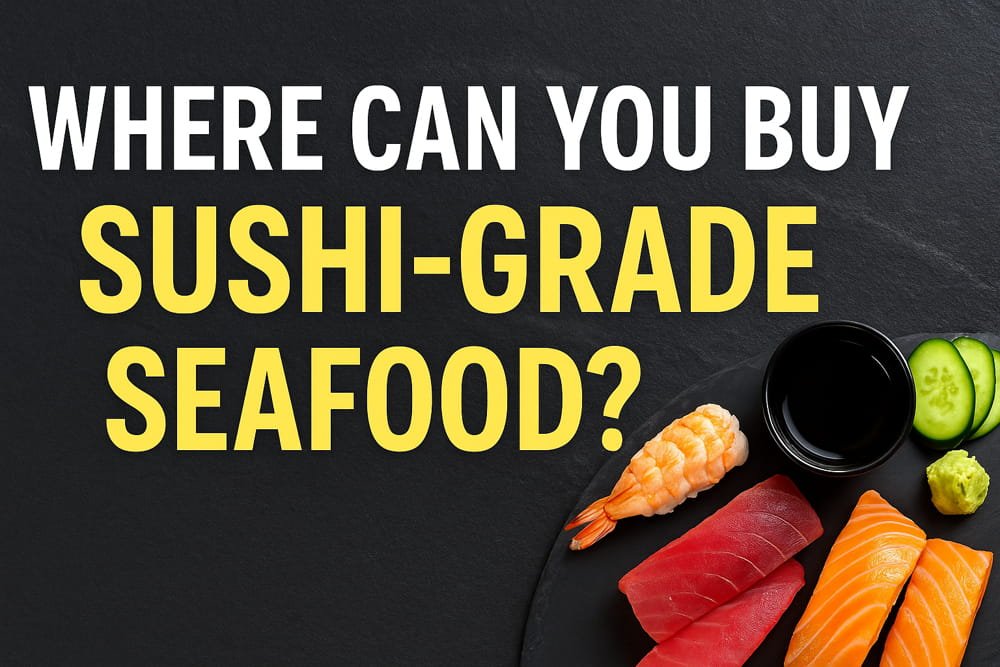Making sushi at home has become increasingly popular as people seek healthier dining options and greater control over ingredient quality. However, preparing sushi safely at home requires more than just culinary skills—it demands sourcing seafood that is specifically safe for raw consumption. Consuming raw fish that does not meet strict safety standards can lead to serious health risks, including parasitic infections and foodborne illnesses.
This guide provides clear answers to the most critical questions: What exactly qualifies as sushi-grade seafood? Where can you confidently purchase it? And how can you verify its safety before serving it raw? Whether you prefer visiting local Asian markets or ordering from reputable online suppliers, this article will help you identify trustworthy sources and ensure the seafood you serve is both safe and delicious.
Contents
- 1 What Does “Sushi-Grade” Seafood Mean?
- 2 Is It Safe to Eat Raw Fish Purchased from Markets?
- 3 Where Can You Buy Sushi-Grade Seafood Locally?
- 4 Where Can You Buy Sushi-Grade Seafood Online?
- 5 What Should You Check Before Buying Sushi-Grade Seafood?
- 6 Which Types of Fish Are Best for Making Sushi at Home?
- 7 How Should You Store Sushi-Grade Seafood at Home?
- 8 How Can You Tell If Sushi-Grade Seafood Has Gone Bad?
What Does “Sushi-Grade” Seafood Mean?
Sushi-grade seafood is fish that has been frozen and handled under strict conditions to eliminate parasites and ensure it is safe for raw consumption. The term “sushi-grade” is not an official regulatory classification but a commercial standard indicating that the product meets the safety requirements for eating raw.
How Is Sushi-Grade Seafood Different from Regular Seafood?
Sushi-grade seafood undergoes flash-freezing at -20°C (-4°F) or lower for at least 7 days to kill parasites. Regular seafood does not follow this mandatory freezing protocol and is typically sold for cooking, not raw consumption. Additionally, sushi-grade products are handled in sanitized environments to prevent bacterial contamination.
What Types of Seafood Are Commonly Labeled as Sushi-Grade?
There are 5 popular types of seafood labeled as sushi-grade, including:
- Tuna (Bluefin, Yellowfin, Bigeye) – Known for its high fat content and clean flavor.
- Salmon (Farmed Only) – Wild salmon often carries parasites; farmed salmon is considered safer for raw use.
- Hamachi (Yellowtail) – Highly valued for its buttery texture.
- Ebi (Shrimp) – Typically served after a light cooking process but sourced as sushi-grade for safety.
- Scallops – Used raw in nigiri and sashimi dishes due to their sweet, delicate flavor.
Is It Safe to Eat Raw Fish Purchased from Markets?
Raw fish is only safe to eat if it has been processed and labeled as sushi-grade by reputable sellers. Fish purchased from regular markets, even if fresh, may contain harmful parasites or bacteria that are not neutralized without proper freezing protocols.
What Are the FDA Guidelines for Consuming Raw Seafood?
The FDA requires freezing fish intended for raw consumption at -20°C (-4°F) for at least 7 days or at -35°C (-31°F) for 15 hours. This process effectively kills parasites such as Anisakis, which commonly infest raw fish. Sellers offering sushi-grade fish must comply with these guidelines to ensure consumer safety.
How Do Flash-Freezing and Parasite Destruction Play a Role?
Flash-freezing is the critical method used to destroy parasites in raw fish. By rapidly reducing the fish’s internal temperature, flash-freezing preserves texture and flavor while ensuring safety. This method is mandatory for all sushi-grade seafood to meet health regulations and eliminate the risk of parasitic infections.
Where Can You Buy Sushi-Grade Seafood Locally?
You can buy sushi-grade seafood at certified Asian markets, high-end grocery chains, and specialty seafood suppliers. These sources typically follow strict handling and freezing protocols that meet FDA safety standards.
Are Japanese or Asian Supermarkets Reliable for Sushi-Grade Seafood?
Japanese and Asian supermarkets are among the most reliable local sources for sushi-grade seafood. Stores like Mitsuwa Marketplace, H Mart, and 99 Ranch Market offer dedicated sushi sections with clearly labeled products. These stores often source directly from certified seafood distributors and maintain proper freezing and storage conditions.
Can You Find Sushi-Grade Fish at Major Grocery Chains (e.g., Whole Foods, Costco)?
Yes, Whole Foods and Costco carry sushi-grade seafood, but availability varies by location. Whole Foods typically labels their sushi-grade fish clearly, and their seafood departments follow strict handling procedures. Costco offers bulk frozen sushi-grade options such as ahi tuna and farmed salmon, often in vacuum-sealed packaging to preserve freshness and safety.
Where Can You Buy Sushi-Grade Seafood Online?
Sushi-grade seafood is widely available through specialized online retailers that guarantee proper freezing, packaging, and overnight delivery. Buying online allows access to premium seafood varieties that may not be available locally, with full transparency on sourcing and handling methods.
Which Are the Most Trusted Online Retailers for Sushi-Grade Fish?
There are 5 highly reputable online sources for sushi-grade seafood, including:
- Catalina Offshore Products – Specializes in sushi-grade tuna and uni (sea urchin), offering overnight shipping nationwide.
- Fulton Fish Market – Provides a wide selection of fresh and frozen sushi-grade options, including salmon and scallops.
- Sea to Table – Focuses on sustainably sourced seafood with clear origin tracing for each product.
- Honolulu Fish Company – Offers premium Hawaiian-sourced sashimi-grade fish, including Yellowfin and Bigeye tuna.
- Lummi Island Wild – Known for its sustainable wild-caught salmon, handled specifically for raw consumption.
How Is Sushi-Grade Seafood Shipped to Ensure Freshness?
Trusted online retailers ship sushi-grade seafood using overnight delivery with insulated packaging and dry ice to maintain the required temperature. Packaging is designed to keep fish at or below -20°C (-4°F) until it reaches your door. Upon arrival, the seafood should be stored immediately in a freezer or consumed within the same day if kept refrigerated.
What Should You Check Before Buying Sushi-Grade Seafood?
Before purchasing, verify the seller’s safety protocols, certifications, and freezing methods to ensure the seafood is safe for raw consumption. Even if a product is labeled “sushi-grade,” without verified handling standards, it may not meet the safety criteria for raw consumption.
How Can You Verify the Source and Handling Procedures?
Check for clear product labeling, supplier certifications, and detailed descriptions of freezing protocols. Trusted sellers provide information about when and how the seafood was frozen and processed. Additionally, look for supplier affiliations with recognized seafood safety organizations like the Global Aquaculture Alliance (GAA) or the Marine Stewardship Council (MSC).
What Labels and Certifications Should You Look For?
Focus on these 4 essential labels and certifications:
- FDA Compliance Statement – Confirms adherence to parasite destruction protocols.
- MSC Certification – Indicates sustainable and responsibly harvested seafood.
- Best Aquaculture Practices (BAP) Certification – Ensures farmed seafood meets strict safety and environmental standards.
- Sashimi-Grade or Sushi-Grade Labeling – Provided by reputable sellers to indicate raw consumption safety.
Which Types of Fish Are Best for Making Sushi at Home?
The best fish for homemade sushi are species known for their firm texture, rich flavor, and safety when consumed raw. These fish types are commonly sold as sushi-grade and meet FDA freezing guidelines.
Which Fish Types Are Safest for Beginners?
There are 4 fish types considered safest and easiest for beginners to prepare:
- Tuna (Ahi, Yellowfin) – Naturally low in parasites, requiring minimal preparation.
- Farmed Salmon – Safer than wild-caught due to controlled farming environments.
- Hamachi (Yellowtail) – Known for its buttery flavor and soft texture.
- Ebi (Shrimp) – Typically served lightly cooked but safe when sushi-grade and flash-frozen.
Are There Specific Cuts of Fish That Are Better for Sushi?
Yes, belly cuts like toro (from tuna) and salmon belly are prized for their high-fat content and rich flavor. For leaner cuts, consider akami (lean tuna) or back-loin sections of salmon, which offer cleaner flavors and firmer textures ideal for sushi rolls and sashimi.
How Should You Store Sushi-Grade Seafood at Home?
Sushi-grade seafood must be stored at temperatures below -20°C (-4°F) to maintain safety and freshness. Improper storage can lead to bacterial growth and spoilage, even if the seafood was initially handled correctly.
What Is the Proper Temperature for Storing Raw Fish?
The ideal storage temperature for raw, sushi-grade fish is -20°C (-4°F) or lower. This prevents bacterial growth and keeps the fish safe for raw consumption. If you plan to eat the fish within 24 hours, it can be refrigerated at 0°C to 4°C (32°F to 39°F), but it should not remain refrigerated longer than that without freezing.
How Long Can Sushi-Grade Fish Be Safely Kept?
- Frozen Storage: Up to 3 months at -20°C (-4°F) without loss of quality.
- Refrigerated Storage: Maximum of 24 hours before consumption.
Always store the fish in airtight, vacuum-sealed packaging to prevent freezer burn and odor contamination. Once thawed, consume immediately and never refreeze.
How Can You Tell If Sushi-Grade Seafood Has Gone Bad?
Spoiled sushi-grade seafood can be identified quickly through visual appearance, smell, and texture. Understanding these signs ensures you avoid health risks and maintain the highest quality for your homemade sushi experience.
What Are the Visual Signs of Spoiled Raw Fish?
There are 5 unmistakable visual signs indicating that sushi-grade seafood is no longer safe for consumption:
- Discoloration – Fresh tuna should appear bright red, and salmon should retain a vibrant orange color. Any gray, brown, or dull patches indicate spoilage.
- Dull Surface – The fish should look glossy and slightly translucent. A cloudy or matte finish signals deterioration.
- Dry or Hardened Edges – This often results from freezer burn or prolonged air exposure, compromising both safety and texture.
- Slimy or Milky Coating – A slimy film or cloudy liquid around the fish surface is a strong indicator of bacterial growth.
- Loose Flesh Structure – The flesh should remain firm and elastic. If it flakes apart easily or feels mushy, it has degraded beyond safe consumption.
Does the Smell of the Fish Indicate Its Freshness?
Absolutely. Fresh sushi-grade seafood emits a mild, clean ocean scent and never smells “fishy” or sour. Any trace of ammonia-like odor is a clear warning that the fish is spoiled and should be discarded immediately to prevent foodborne illness.
By mastering these freshness indicators, you not only protect your health but also ensure that every homemade sushi dish delivers the authentic flavor and texture you expect. Always prioritize quality over convenience when sourcing and storing raw seafood. And remember, practicing proper storage of sushi-grade seafood is just as important as selecting a trustworthy supplier to maintain safety and flavor from purchase to plate.



